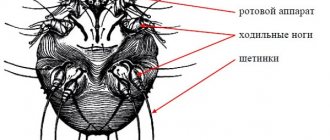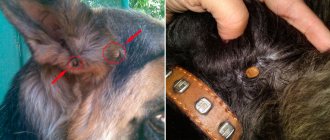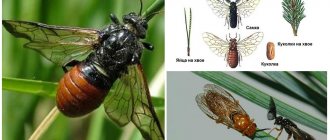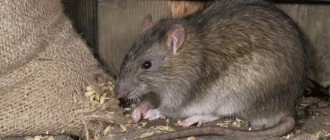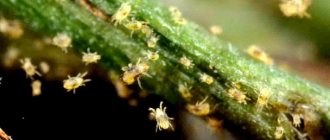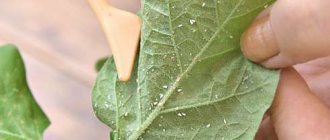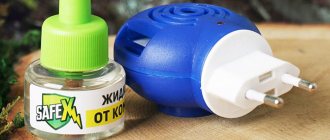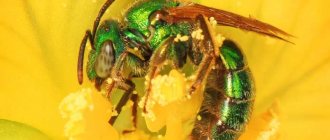Description of the pest
This small pest loves to feast on roses most of all. Moreover, regardless of whether the rose grows as a bush or curls along the wall, this plant is the favorite habitat of spider mites. The leaves of a mite-affected rose begin to turn yellow and dry out, the plant loses moisture, becomes depleted and withers.
Spider mites are very small in size. You can see it only with the help of magnification, for example, using a magnifying glass.
On a note! Female spider mites are larger than males.
These pests live in large groups, each of which contains more than a hundred individuals. The first sign of the presence of parasites on a rose is a thin web on the underside of the leaves. Adults hide under it, laying eggs. Gradually, the colony spreads over the entire surface of the leaf.
An adult spider mite has an oval-shaped body and four pairs of legs. The larvae have three pairs of them. The average size of the parasite is about 0.5 mm. Moreover, females have a size of 0.4-0.6 mm, males - no more than 0.4 mm. Spider mites have a soft cover. The body is flat below, slightly convex above. In the larval stage, insects are almost transparent. Over time, they acquire a pale greenish or greenish-brown tint. There are dark spots on the sides. Wintering females have a red or bright red color from autumn to spring.
Note! The spider mite lives relatively short, a little more than four weeks. However, despite such a short period of time, females manage to lay more than a hundred eggs, from which young larvae are born after a couple of days.
What is a tick
Spider mites belong to the category of arthropods, therefore, strictly speaking, they cannot be classified as insects. The size of the mite is very small, it is difficult to see it with the naked eye, only when looking closely at the rose bushes can you notice small bugs, the size of a grain of sand. This is a tick. Females are usually larger than males, measuring about 0.4-0.6 mm, while the body of males is 0.2-0.4 mm long. Sometimes the adult size can reach up to 1 mm, but such mites are rare.
Spider mite
The color of the pest is bright red, less often orange or yellow, which makes it difficult to detect on rose flowers of red and burgundy shades. When the colony becomes too numerous, they become noticeable on the bush due to their bright color. Mite larvae are light green and are also difficult to find on the inside of the leaf.
Spider mites reproduce quite quickly, as if compensating for the fact that not all individuals survive the winter. A female tick is capable of laying up to 400 eggs in one clutch; over the summer there can be more than 20 such clutches. The larvae in the egg mature within 10-14 days, after which the larva is born and passes into the nymphal stage. After several molts, the larva turns into an adult. Larvae have three pairs of legs, nymphs and adults have 4 pairs each. The lifespan of the parasite is relatively short - only one and a half to two months, but even during this period they are capable of causing severe damage to plantings on the site.
Spider mite larvae
Ideal conditions for living and active reproduction of mites are low humidity (less than 50%) and high temperature (25-35 degrees), so rainy weather or a sudden cold snap can help in the fight against spider mites.
Insects often overwinter in fallen leaves, cracks in the bark, on weeds, and unharvested old bushes, but not all individuals survive. You can also infect healthy plants by planting infected bushes next to them.
Arthropods spread throughout the area with the help of larger insects, birds, animals; strong wind also contributes to the spread. Spider mites can get onto indoor flowers from the street, for example through a window. Spider mites produce webs, with the help of which they also “travel.”
Appearance of spider mites and signs of plant infection
In appearance, this is a small insect with a round body covered with bristles and a variety of colors. You can see them on the bottom of the leaves, on the ground or on the window frame. Females are significantly larger in size than males. This type of pest multiplies rapidly and has the ability to move from one plant to another. An adult female can lay several hundred eggs on a single rose. The eggs are particularly resilient and can remain in various secluded places for up to five years.
The first signs of pest activity are small white dots and minor damage to the foliage; later the spots increase in size, and the affected areas of the flower completely change color. Rose buds become smaller and more inconspicuous. Spider mites pierce the leaves of the plant and feed on its sap, which leads to its gradual withering and drying out.
The web on domestic roses is also a sign of pest activity; it can contain a large number of insects, because mites prefer to stay in groups. In advanced forms of the disease, the flower may become completely covered with cobwebs.
Warning! Spider mites, in addition to feeding on plant cells, depriving them of vitality, are also carriers of various infections, such as gray rot and others.
Spider mite on a rose
The insect settles on both home and garden flowers. The mite attacks various plants, but most of all it loves strong and juicy roses. The difficulty of eliminating the parasite is that it develops rapidly, and although its lifespan is short, up to 1 month, during this time the female manages to lay thousands of eggs.
How does a mite get on a flower?
The carrier of mites is the wind, which carries them from one plant to another.
Spider mites are one of the most destructive insects for roses.
The insect is carried into the apartment on shoes and items of clothing, and with the wind - through windows.
Preventive measures
It is better to prevent the appearance of spider mites than not to know how to get rid of them later. The pest does not reproduce in a humid environment, so you need to constantly create it. Daily spraying of the “queen of flowers” will help soften the dry air in the room and will be the best protection against aggressive arachnids.
Roses - indoor and garden - require regular watering, especially during the growing season. But it is also impossible to over-moisten the soil and flowers, so as not to provoke fungal infections. In the garden, you need to limit the use of insecticides - broad-spectrum preparations, together with pests, kill many beneficial insects. It is after such treatment that a massive invasion of spider mites is observed. Excessive fertilization with nitrogen-containing fertilizers also benefits this predator. It is important to maintain a balance and not forget about potassium, which creates an environment that is “unfriendly” to the pest.
Dry leaves and faded buds must be removed immediately. In the rose garden, before sheltering for the winter, all plant debris is removed so that parasites do not overwinter in them. The earth around them is being dug up deeply.
Causes of rose infection
One of the reasons for the appearance of spider mites on roses is wind. In dry weather, mites are transferred from one plant to another, spreading throughout the entire garden plot. If the rose is weakened or not properly cared for, then the spider mite will settle on it first.
Cold weather is detrimental to ticks. He is also afraid of rain. Birds also help fight the pest, for which ticks are an excellent treat. However, this only slightly reduces the insect population. These factors are not enough to completely solve the problem.
Spider mites on roses
When growing indoor roses, some gardeners mistakenly believe that a dry and warm microclimate will be favorable for plants. This opinion is completely wrong. These conditions are the main cause of indoor rose infection. Dry air is an ideal breeding ground for spider mites. The tick does not tolerate wet environments.
Reasons for the appearance of mites on indoor roses
Often, caring housewives keep indoor plants in warm and dry climates, mistakenly thinking that such conditions are most favorable for plants. But in fact, such an environment contributes to the appearance and active reproduction of spider mites, which in a short period of time can spread en masse on all plants located next to the affected one. That is, the main cause of the pest is dry air and high ambient temperature. This is why plants most often get sick during the heating season and during dry, hot summers.
Insects also attack plants that are not properly cared for. For example, an indoor rose really needs moisture during the growing season, and if this is not done, then there is a risk of it being attacked by mites. Insects primarily attack weakened roses that have no immunity and suffer from a lack of nutrients. But overfertilization, improper watering, and lack of sunlight also increase the risk of pests. Therefore, knowing how to properly care for flowers and creating a certain climate, you can avoid the appearance of spider mites. But if you still cannot avoid infection, then it is important to quickly begin an effective fight against parasites.
Methods for controlling spider mites
The spider mite is the most dangerous parasite for roses, which not only destroys the plant where it settles, but also quickly spreads to neighboring flowers. It is difficult to fight it, but it is possible if you take timely measures.
Isolating plants in the garden and in the house
As soon as cobwebs are noticed on domestic roses, they should be immediately isolated in a separate room. This is done in order to prevent the parasite from spreading to other plants.
Insulation is more difficult in the garden. The rose bush can be covered with a darkening mesh or agrofibre.
A stream of water will help knock off most of the parasites from roses, which will greatly facilitate further war against them.
Note! Before covering or isolating a flower, it is necessary to remove as many parasites as possible from it. You can carry out mechanical cleaning using a shower, under which you place a pot with an indoor rose. Garden flowers are doused with water from a hose under pressure.
Drastic bush pruning
Damaged parts of the rose cannot be restored. They need to be trimmed.
Cleaning leaves from cobwebs
The cobwebs are removed from the bush by hand; they can be wound around a stick. Small parts of the threads are washed off with water under pressure.
Spraying
A soap solution is highly effective in removing mites and cobwebs. They need to spray the infected bushes.
What else can you spray roses against pests?
Here we describe what else you can spray roses against pests to get rid of insects.
“Molniya” is a drug for exterminating insect pests of ornamental and other crops on private farms. It is distinguished by a fast initial and long-lasting protective effect. The drug is economical and easy to use, meets international standards of quality and safety of use.
Prepare a solution for spraying plants immediately before treatment. Pour 1-2 liters of water into a bucket, open the ampoule (2 ml) or bottle (10 ml), pour the required amount of the drug into a bucket of water and move carefully, then bring the working solution to 10 liters and mix again.
For best results, spray the plants with a freshly prepared solution in dry, windless weather in the morning or evening. Apply the working solution using a sprayer, giving a fine spray on the underside and top of the leaves. When spraying, it is necessary to ensure uniform wetting of the leaves. The optimal temperature for treatments is from +12 to +25°C.
The speed of impact on insects is within the first hour after treatment. The period of protective action is at least 14 days. To prevent insects from becoming accustomed to the drug, the use of insecticides from different chemical groups should be alternated.
When used on private farms, do not mix with other drugs.
This product against rose pests is dangerous for bees, so do not treat during flowering. Do not allow the drug to get into bodies of water.
"Fufanon" is a means to combat insect pests.
In the fight against numerous pests of garden crops, we are forced to use various types of drugs. "Fufanon" is one of them. This is an analogue of Karbofos.
When preparing the Fufanon working solution, pour 1-2 liters of water into a bucket, open the ampoule, pour 5 ml of the drug into a bucket of water and mix thoroughly.
Spray the plants with a freshly prepared solution in dry, windless weather in the morning or evening, wetting the leaves evenly. The optimal temperature for treatments is from +12 °C to +25 °C. Avoid contact of the working solution with neighboring crops. Strictly observe the waiting period after processing. Do not spray against the wind.
The speed of impact on insects is within the first hour after spraying. To prevent insects from becoming accustomed to the drug, the use of insecticides from different chemical groups should be alternated. The period of protective action of “Fufanon” is at least 14 days.
Amateur gardeners are not recommended to mix this pesticide with other preparations.
Fufanon is dangerous for bees, so do not treat the plant during flowering. Dangerous for fish - do not allow the drug to get into bodies of water.
"Actellik" is a pest control drug for a wide range of crops in various growing conditions (in a greenhouse, in a garden, in a vegetable garden).
In greenhouses it is effective against pests, including spider mites, whiteflies, aphids, thrips, with a waiting period of 3 days between the last treatment with the drug and harvest.
Actellik has a wider spectrum of action than pyrethroid drugs because it contains organophosphorus compounds. It causes the death of pests through contact action (drops of working fluid falling on the outer covers of the insect); intestinal (the drug enters the pest’s body along with food), as well as fumigative action (the effect of drug vapor on pests).
Actellik’s ability to destroy pests with its vapors makes the drug indispensable when it is necessary to treat hard-to-reach places. Redistribution of the drug throughout the plant enhances its effect on pests living on the underside of the leaf.
Actellik is used by spraying plants. 15-30 ml of the drug is stirred in 10 liters of water. Spray if there are pests on plants. Repeated treatment (if necessary) - with an interval of at least 5 days. The consumption rate of working fluid is 4-7 liters per 100 m2.
To successfully combat whitefly, 3-4 times treatment is recommended. Such a spraying schedule will disrupt the pest development cycle and provide high-quality plant protection from both larvae and adults. Pest control in the wintering stage is less effective.
To protect against spider mites and thrips, two and three times treatment is recommended with an interval of 7-10 days.
One spray is enough against aphids.
For high-quality spraying, use a sprayer with a fine-droplet or fog-forming spray, which ensures uniform coverage and wetting of the leaf surface of plants.
Warm and humid conditions of protected soil enhance the effect of the drug in vapors and ultimately increase its effectiveness.
In open ground, Actellik is used against aphids, moths, beetles, butterflies, caterpillars, mites, and whiteflies.
"Aktellik" can also be used to combat household insects (cockroaches, flies, fleas, ticks, mosquitoes). Read the instructions for the drug.
“Pochin” is a soil-dwelling insecticide against soil-dwelling insect pests of flower and other horticultural crops.
To apply the drug evenly, fill a liter container 3/4 full with dry sand, add the contents of the bag (30 g) and mix thoroughly.
The drug is not phytotoxic. The effect of the drug appears within 24 hours after use. The period of protective action is 6 weeks. Pochin should not be mixed with other drugs. Insects do not become accustomed to the drug.
"Zemlin" is a product for protecting flower crops from soil-dwelling insect pests.
The contents of the package (30 g of the drug) are designed to treat 10 m2 of flower crops.
To uniformly apply the drug, fill a half-liter container with dry sand or sawdust, add the contents of the bag and mix thoroughly.
For flower crops, apply the mixture to the soil before planting.
"Alatar" is a universal drug for controlling insect pests in gardens and private farms. Destroys 28 types of pests! Deals a double blow to pests, as it contains two active ingredients at once.
Consumption of the drug is 5 ml per 10 liters of water for spraying 100 m2 of vegetable or flower crops or from 2 to 5 fruit trees, depending on their age and crown size.
It will protect apple, pear and quince trees from codling moths, leaf rollers, sawflies, flower beetles, copperheads, apple moths, aphids, and moths.
The frequency of spraying is no more than two, the waiting period before harvesting is 30 days.
- Author: Tatyana
Rate this article:
- 5
- 4
- 3
- 2
- 1
(52 votes, average: 4.5 out of 5)
Share with your friends!
A cobweb appeared on a rose: what to do at home
There are two main methods to fight bugs:
- chemicals;
- folk remedies.
The choice depends on how severely the plants are affected.
Chemicals
Spider mites belong to the class of arachnids. Chemicals designed to kill insects—insecticides—have no effect on ticks. What to do if a cobweb appears on a home or garden rose? You need to use anti-spider agents - acaricides, which are divided into 2 types:
- Insectoacaricides are drugs that have a detrimental effect on both spider mites and other pests.
- Specific acaricides are compounds and mixtures that act only on ticks. They differ in chemical composition and are contact-action drugs, that is, they act on parasites through direct contact with the integument of their body.
Insectoacaricide treatment
The most popular acaricides:
- Actellik is an effective drug belonging to the organophosphorus group. The principle of action is enteric contact. The active component of the drug, pirimiphosmethyl, has a negative effect on insects. After treatment, the effect lasts about two weeks. Plants need to be treated 2 times with a break for a week. This is a highly toxic substance, so it should not be used to treat plants in an apartment. Method of preparation: dilute one ampoule (2 ml) in 1 liter of water. Apply the resulting solution with a sprayer to the above-ground parts of plants. When processing, special attention should be paid to the lower part of the leaves, where the largest concentration of spider mites is usually observed.
- Apollo - does not lead to the death of adults, destroys only the eggs and larvae of parasites. It has a unique ability to have a sterilizing effect on adults, as a result of which they stop reproducing. The active ingredient is clofentesine. The effect of the treatment lasts about three months. It is recommended to spray the affected plants twice. Method of preparation: ampoule (2 ml) is diluted in 5 liters of water.
- Fitoverm is a biological product that has an intestinal-contact effect. It is created based on the waste products of the fungus Stereptomyces avermitilis, which is found in the soil. The drug is quite safe, it can be used to treat indoor plants. To achieve a more effective result, you need to treat the plants 3-4 times with intervals of 7 days. To prepare a solution for treatment, you need to dilute 2.5 ml of the product in 1.25 liters of water.
- Floromite is a drug that destroys parasites that are in the active stage of development. The active ingredient is biphenazate. The effect of the drug begins to appear within a couple of hours after treatment. After 3-4 days the drug reaches its peak effectiveness. Plant protection lasts for three weeks. Treatment should be carried out twice with a seven-day break between sprayings. The preparation method is the same as for Apollo: an ampoule (2 ml) is diluted in 5 liters of water.
Important! If the recommendations for using Floromite are not followed, ticks develop resistance, i.e., the body becomes resistant to the drug. It is necessary to carefully study the instructions before starting processing.
All medications must be used strictly following the instructions, because spider mites have natural enemies among insects that can be killed if you are overly enthusiastic about using chemicals. In addition, if you frequently treat roses with preparations based on phosphates and plant insecticides, this will lead to an increase in the concentration of nitrogen on the surface of the leaves and, as a result, the creation of favorable conditions for the life of spider mites.
Important! Parasites easily adapt to insecticides, so the drugs need to be alternated periodically. Moreover, it is necessary to ensure that when changing, a drug with a different active ingredient is used.
Folk remedies
If cobwebs appear on roses and the leaves dry out, then in some cases you can get rid of white spider mites using folk remedies. This method is environmentally friendly and can quite effectively, especially at the initial stage of infection, solve this problem and save the rose.
Treatment with products prepared according to folk recipes should be carried out 3 times at weekly intervals. Examples of folk remedies:
- Garlic. To spray plants in the garden, you need to prepare a garlic tincture. To do this, 0.5 kg of garlic is crushed, placed in a container and filled with 3 liters of water. Then the container must be placed in a warm place for 5 days. After this, the tincture must be strained. To use, you need to dilute about 60 ml of solution in 10 liters of water and add 50 grams of laundry soap. Treat the plant and soil with the resulting product.
- Black henbane. Pour 1 kg of crushed dry henbane with water in an amount of 10 liters. Place in a warm place for 12 hours. Afterwards, strain. Then add about 45 grams of laundry soap and treat the rose bushes affected by the mite.
- Laundry soap. Dissolve laundry soap in water until a rich foam forms, after grinding it. Apply foam to a foam sponge and wipe the leaves and stems where cobwebs have formed. It is better not to treat the soil with soapy water or to irrigate it very little, being careful not to get it on the roots of the plant. If you overdo it, the roots are severely damaged, resulting in the plant drying out.
Spraying with soap
How to spray roses against pests: preparations for treating plants
In this section of the article you will learn how to treat roses from pests in your garden.
"Akarin" is a biological preparation against insect pests. It has a wide spectrum of action: all types of herbivorous mites, sawflies, leaf rollers, thrips, as well as all types of aphids.
The drug does not pollute the environment and is quickly destroyed in soil and water. The waiting period from the last treatment to harvesting is no more than 3 days. Remains highly effective in hot weather.
Preparation of a working solution for treating roses against pests: pour 0.5 liters of water into a bucket, open the ampoule and pour its contents into a bucket of water and mix thoroughly, then bring the working solution to the required volume and mix again.
Spray plants in dry, clear and windless weather in the evening or morning, evenly wetting the leaves. The optimal temperature for treatments is from +18 to +34 C. The period of protective action is from 3 to 5 days. The speed of exposure is 4-8 hours.
When used on private farms, do not mix with other drugs. Not phytotoxic. Storage of the working solution is not allowed. The shelf life of the drug is 2 years.
"Agravertin" is a biological insectoacaricide (anthelminth). This domestic product is a new generation of plant protection products, successfully combining high efficiency, selectivity, ultra-low doses of active substance consumption and mild sanitary, hygienic and environmental characteristics. Treatment should be carried out in the presence of pests.
"Agravertin" is a natural, environmentally friendly, enteric-contact preparation for pest control, isolated from a non-pathogenic soil fungus.
To destroy pests on indoor plants, an ampoule of the drug should be dissolved in 1.5 liters of water. Spraying is carried out in the evening 2-3 times with an interval of 3-4 days.
The drug is highly effective against spider mites, red mites, all types of openly sitting aphids, and thrips. It affects the nervous system of the insect, causing first paralysis and then death. Feeding and physical activity stop 11-16 hours after treatment, the death of pests occurs on the 2-3rd day after treatment, and the maximum effect from using the drug occurs on the 5-6th day.
The drug is used to treat plants by spraying with any type of sprayer that provides fine atomization and uniform wetting of the treated surface. To protect against pests, roses are sprayed in dry, clear, windless weather at a temperature of +18...+20°C, when precipitation is unlikely in the first 8-10 hours. Light precipitation or heavy dew reduces the effectiveness of the drug.
To prepare the working solution, do not use food containers; carry out processing in the absence of children and animals. Store ampoules separately from food and medicines, in a dark, inaccessible place.
"Fitoverm" is a biological insecticide and acaricide. Recommended for controlling mites, aphids and thrips on roses.
Dissolve the contents of the ampoule (4 ml) in water. Spray the plants with the resulting solution when a pest appears.
Spraying roses against pests is carried out with a freshly prepared solution in dry, windless weather in the morning and evening hours, evenly wetting the leaves. In protected ground, mass death of pests occurs after 6-8 hours, in open ground - 8-16 hours. The duration of the protective effect is from 7 to 20 days after treatment.
The drug is dangerous for bees; do not treat during flowering. Dangerous for fish, do not allow it to enter water bodies.
“Spark Double Effect” is a universal tablet against insect pests that successfully protects plants from more than 60 types of pests.
Quick and effective removal of spider mites on roses
Almost every plant lover has encountered the appearance of pests. Spider mites on roses are of particular concern to lovers of fragrant flowers. It is these insects that pose the greatest threat to the life of tender plants, so it is important to quickly detect and eliminate them. If you catch them in time, you can get rid of them in a fairly short time - and the rose will grow and prosper intensively.
Spider mites are very small - no more than a millimeter, so it can be difficult to notice them with the naked eye
The result of the activity of a spider mite
If the number is small, the pests will not bother you much, but if the ambient temperature is high for a long time, the spider mites will multiply very quickly and after some time they will seriously damage the rose. Since they feed on plant juices, they are quickly depleted and, as a result, instead of strengthening their root system, they devote all their energy to replenishing nutrients. The foliage begins to gradually become covered with black dots, then turns yellow and falls off.
Spider mites often settle not only on the leaves, but also on the stem and buds. In these areas you will also find a thin web with tiny grains of sand moving underneath it. And if you do not take the necessary control measures in time, you can lose most of the rose bushes.
On a note! Spider mites are most dangerous for young seedlings. And if the damage from the parasite is aggravated by a dry climate and poor watering, then the young roses will not even have time to form healthy buds!
Spider mites on roses: prevention
Spider mite on a rose: photo
It is always better to prevent the appearance of a parasite than to fight it and the consequences of its activity.
Prevention means are not complicated, but effective.
- Conduct ongoing visual inspections of your roses, paying particular attention to the plant's leaves.
- Before you start treatment, make sure that your pest is a spider mite.
- When purchasing a new flower for your garden or greenhouse, do not forget about the quarantine of the new plant. A few weeks away from the “old people” will allow you to make sure that there are no infestations or pests.
- Create negative living conditions for spider mites. This is especially convenient because these conditions, on the contrary, are favorable for your roses.
- Pay attention to which plants you have next to each other. For example, in addition to roses, the tick loves orchids. By placing them nearby you will contribute to the proliferation of the pest.
- Treat the soil and plants to remove fallen leaves.
- Soap solution helps in prevention. Use a damp cloth to wipe down window sills, pots, shelves, and all areas where your plants are located.
These are all recommendations and ways to combat spider mites on roses. By performing them, you will only enjoy the aroma and beauty of the flower.
Spider mite on a rose: video
Description of the parasite and causes of appearance
Spider mites belong to the class of arthropods and annoy flowers quite often. They are able to very quickly move to neighboring plants, where they establish new colonies that multiply at high speed. The difficulty of detecting such microscopic insects is the main reason that the problem becomes noticeable only when the stem, leaves and flowers are severely damaged.
The size of the mite is 0.2-0.5 mm, the body is oval and covered with hairs, colored red or brown (see photo of a spider mite on roses). Such a creature can only be seen under a microscope. They live everywhere: on the stem, leaves, shoots, inflorescences. The pests' diet consists of plant juices, which they suck from all parts of the flower. Females are able to reproduce very quickly, laying eggs, from which young, voracious green larvae appear within a couple of days.
They can enter indoor plantings through windows or from the soil when purchasing decorative flowers in a store.
On a note!
Spider mites settle on decorative flowers, including roses, when favorable conditions arise. They prefer a dry and warm microclimate, but cannot tolerate high humidity. In the absence of frequent watering, with dry soil in the garden or indoor conditions, the risk of invasion and transition between plants increases sharply, which can be disastrous for delicate roses.
Spider mite on a rose
Prevention
The gardener should take care in advance to prevent the appearance of spider mites on roses, so as not to waste energy fighting them later. Preventive measures are quite simple and do not require any costs:
- Periodically inspect the leaves of plants. When cobwebs appear on the leaves, you should make sure that it is the spider mite that is to blame, and only then apply the necessary preparations.
- Isolate the newly purchased plant in a separate room for several weeks.
- Avoid dry air. Water your plants regularly, as damp conditions are an uncomfortable breeding ground for spider mites.
- Periodically wipe flowerpots and pots with soapy water, as well as the places where they stand.
- Periodically remove and burn fallen leaves on the site.
- If there are orchids in the house, in addition to roses, then these plants should be placed as far from each other as possible. Otherwise, having infected all the roses, the mites will spread to the orchids.
Spider mites are an unpleasant phenomenon. However, if you follow all preventive recommendations, you can avoid infecting plants with this parasite. And then the beautiful pink buds will lift your spirits and delight the eye with their blooming appearance.
How to treat roses against pests: preparations for spraying bushes
If you don’t know what to spray roses against pests, use the following products.
"Confidor" is a water-soluble, systemic insecticide with contact-intestinal action against sucking and gnawing pests. Used for spraying plants during periods of mass pest emergence.
The working solution is prepared immediately before treatment. 2-3 liters of water are poured into a bucket, the required amount of the drug is measured (in accordance with consumption rates) and poured into a bucket of water, mixed thoroughly, then the solution is brought to the required volume (5-10 liters) and mixed again.
Spray the plants with a freshly prepared solution in dry, windless weather, preferably in the evening (18-22 hours) or in the morning (up to 10 hours), evenly wetting the leaves, 4-6 hours before the rain.
It is necessary to avoid contact of the working solution with neighboring crops. Strictly observe the waiting period after processing. Do not spray against the wind.
The effect of the drug begins immediately after contact with pests or when they eat the treated plant surface. Already in the first hours the food stops. The maximum effect occurs within the first day after use. Duration of action of the drug is up to 4 weeks, depending on weather conditions (precipitation, temperature), method of application and the number of pests.
At recommended consumption rates, the drug is not phytotoxic.
It is prohibited to pour the drug and working solution into ponds and water sources. Spraying of plants should be carried out in the late evening or early morning, when there is no active bee flight.
“Commander” is a highly effective universal drug for the destruction of aphids, thrips, and whiteflies. The drug has contact and systemic effects. It penetrates the upper cellular layers of leaves and provides long-term protection against pests. Thanks to its properties, “Commander” is not washed off by rain and, most importantly, unlike many pyrethroid drugs, it works reliably in hot weather.
The drug protects shoots that have grown after treatment; It is enough to treat the upper side of the leaves to completely protect the plant, while the toxicity of the drug is 7.5 times lower than that of conventional insecticides. When using "Commander", as a rule, one treatment per season is sufficient.
"Commander", packaged in 1 ml ampoules, is very convenient to use.
To get the maximum effect, spray the plants with a freshly prepared solution, wetting the leaves evenly. Carry out the treatment in dry, windless weather in the morning or evening. The optimal air temperature during processing is from +12 to +25 “C. The maximum effect on insects occurs 1-2 days after treatment. The period of protective action is at least 20 days.
When used on private farms, it should not be mixed with other drugs.
"Commander" is dangerous for bees, so do not apply the treatment during flowering. "Tanrek" is a highly effective product for protecting flower crops from pests. To protect against aphids, wildflowers, thrips, and whiteflies, you need 5 ml of Tanrek. Dissolve the indicated dose rate of the drug in 1 liter of water, mix, then add water to 10 liters and mix again. During the growing season of plants, use 10 liters of working solution per 100 m2. Spray with freshly prepared solution in dry, windless weather early in the morning or evening.
The speed of action of the drug on pests is within 24 hours, and the period of protective action is 20-25 days. Not phytotoxic. Release date for manual work: 7 days after processing.
When using Tanrek on private farms, it should not be mixed with other drugs.
"Iskra-M from caterpillars." Sawflies, cutworms, etc. cause enormous harm to roses. To combat them, a special preparation “Iskra-M for caterpillars” was created. This drug has a fast effect. Successfully used in greenhouses.
Sergei Iskra solves almost all problems of pest control, and alternating these drugs prevents pests from becoming accustomed to them.
To get the maximum effect, spray the plants with a freshly prepared solution, wetting the leaves evenly. Carry out the treatment in dry, windless weather in the evening or morning.
The optimal air temperature during processing is from +12 to +25°C. The maximum effect on insects occurs 1-2 days after treatment. The period of protective action is at least 20 days. When used on private farms, it should not be mixed with other drugs.
Spraying is carried out during the period of mass appearance of pests. The waiting period is 20 days.
"Zubr" is a systemic insecticide of contact-intestinal action for the destruction of insect pests on plants.
After spraying, it quickly penetrates the leaves, spreads throughout the plant and provides long-term protection to treated and new young stems and leaves. Pests feeding on such leaves die within a few hours after treatment. Within 1-2 days, almost all harmful beetles and larvae die.
The significant advantages of the preparation “Zubr” are its high efficiency even in hot weather and the fact that it is not washed off from plants by rain. The mechanism of action eliminates the acquisition of pest resistance to the drug and guarantees 100% results.
The preparation "Zubr" is highly effective against sucking pests (aphids, whiteflies and thrips) on flower crops.
The drug is available in two packages: 1 ml and 5 ml. The contents of the ampoule (5 ml) are designed to prepare 50 liters of working solution.
For ease of use of the drug, you can first prepare a concentrate by diluting 5 ml in 1 liter of water, and then diluting 200 ml of concentrate in 10 liters of water to prepare a working solution. The concentrate and working solution must be used on the day of preparation. Treat plants when pests appear in dry, windless weather in the morning or evening, evenly wetting the leaves.
"Aktara" is a drug with enteric contact and systemic action. It is used to protect flower crops from a complex of pests.
"Aktara" has good rain resistance. If it rains 2 hours after treatment, then there is no need to re-treat.
Additional events
You should always monitor the condition of the flowers and take immediate action at the slightest sign of infection. If a parasite is noticed on a plant, it is necessary to rinse it with warm running water, and then wipe the leaves with a low concentration alcohol solution.
Next, you need to choose the most suitable product and treat the rose. Remember that you will also need to treat the window sill and the area where the flowerpots are located. The procedure must be repeated after a week. In order to protect the rose, fertilizer with potassium is applied after the repeated procedure.


